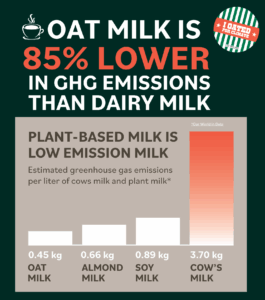How to Flip Your Frappe to Plant Milk—by Default
There’s a change brewing in the coffee industry
The plant-based milk industry is booming, and the market grows yearly as the dairy industry falters. Plant milks now represent 40+% of all milk sold, their rise fueled in large part by younger generations who are eco-minded and racially diverse.12 Coffee shops are quickly adapting accordingly. To keep up with the demand, coffee shops are moving beyond merely offering plant-based milks as an option. They’re flipping the norm and serving plant milks as the default. This phenomenon is emerging worldwide, from Birch Coffee in New York to LinkedIn’s offices in San Francisco to Blue Bottle in U.S. cafes. You can flip the default, too!
Start with the coffee or tea you serve:
- At committee meetings
- In your house of worship
- At the office
- During soccer practice
- At a potluck dinner
- At HOA meetings
If you’re making drinks, use oat milk or plant-based creamer unless someone specifically requests dairy. (Just because someone takes their coffee or tea with “cream and sugar” doesn’t mean you have to supply actual cream. Most people settle for milk, and traditional coffee “creamers” are dairy-free anyway!)
It may be your job to stock the office fridge. Set your team up for success and load up on plant-based milks instead of half-and-half.
When setting out creamers at a party, proudly display the plant milks front and center, making sure to keep the sustainable and inclusive options visible and accessible. If you know some folks want cow’s milk, you can always keep a small reserve in the fridge for special requests.
Of course, the simplest way to serve plant milks as the default is if you’re making coffee for yourself and your family. It’s easy to drop the cow from your cortado or matcha and make your morning cup with oat milk.
What if I get my coffee from a coffee shop?
Totally fine—your local businesses can flip the default, and you can help! Americans drink 60 million lattes3 every year, and specialty beverages like lattes usually come from quick service restaurants and cafes. Local shops are owned by real people who live right in your community and they care about what customers want.
Start a conversation with your local coffee shop, campus cafe, or office manager. Let them know that an easy way to include non-dairy clients is to flip to a plant milk default—automatically making lattes and cappuccinos with oat milk instead of cow’s milk, rather than by special request. You can share our quick-start guide with your shop to teach them why serving plant milks is better.
Put simply, businesses can sell coffee to more people if they replace dairy:
- 30-50 million Americans experience some degree of lactose intolerance.3
- Lactose intolerance is particularly prevalent in communities of color: people of Asian, African, Hispanic, and indigenous heritage are far more likely to be lactose intolerant than white Europeans.4
- 30% of Millennials are trying to eat more plant-based foods. Among Gen Z, that number rockets to 60 percent.5
Flipping the default can help businesses meet their sustainability goals. When Portland coffee shop Guilder Coffee removed its dairy default, plant milk coffees became 18% more popular, reducing Guilder’s carbon footprint by 12%. After all, just one non-dairy latte saves 0.143 kg of carbon dioxide. That adds up quickly!
Did you know that oat milk is 85% lower in carbon emissions than dairy milk?

Meanwhile, Onyx Coffee Lab’s favorite part of implementing an oat milk default is the lower energy bill.6 They save electricity using shelf-stable milks that don’t require refrigeration like cow’s milk. Saving money on electricity serving more customers? Sounds like a recipe for success.
One half of Americans drink coffee every day. That’s millions of opportunities to rethink ritual, choose inclusion, and usher in a more sustainable future. Start your morning off right. Flip the script on your flat white and make your coffee with plant milk.
Need help implementing a plant milk—or the climate leader, oat milk—as the default somewhere? Get in touch with us! We can help your favorite cafe make the switch.
2021 U.S. Retail Market Insights: Plant-Based Foods. Good Food Institute.
Teens Drink 550 Percent More Vegan Milk Than Gen X. VegNews. 2017.
NCA Releases Atlas of American Coffee. National Coffee Association. 2020.
Lactose Intolerance: Information for Health Care Providers. Eunice Kennedy Shriver National Institute of Child Health and Human Development. 2006.
Consumer Insights. Plant Based Foods Association. n.d.
Switching to Oat Milk – And Upping Sustainability. Urnex. 2021.